Fishing experience of a lifetime
The Teno is one of Europe’s most famous and largest salmon rivers, and it flows freely in northern Scandinavia – on the border between Norway and Finland. The Teno is known for its clean waters, which provide ideal breeding conditions for salmon and its related species. Fishing in the Teno fishing waters is both challenging and rewarding, which is why fishing there is a dream for many. The Teno Valley, which extends all the way to Utsjoki, is a beautifully open valley full of lakes, rivers and mountainous landscapes. This area is not only a paradise for fishermen, but also a popular destination for nature lovers and hikers. The isolation and unique nature of the Teno Valley make it a place where you can experience a truly peaceful and natural holiday.
Salmon fishing in the Teno has been prohibited since 2021 due to the protection of the weakened salmon population. In this situation, the focus of fishing tourism has shifted to other forms of fishing and species. Other species can still be fished in the waters of Teno, such as trout, whitefish and grayling. The Teno Valley offers tourists a wide range of accommodation options, fishing trips and guided tours that take them directly to the Teno fishing waters. Here, you can choose whether you want to fish on your own or take advantage of local expert guides who know the fishing spots.
The Teno Valley is not only a fishing destination, but also a rich cultural area where you can experience Sámi traditions and enjoy the beauty of northern nature. Fishing tourism allows you to get to know Sámi culture, learn about the history of the area and participate in local traditions, for example through cooking. The area also offers many other activities, such as hiking and canoeing trips, which offer tourists the opportunity to enjoy the peace of nature even outside of fishing trips.
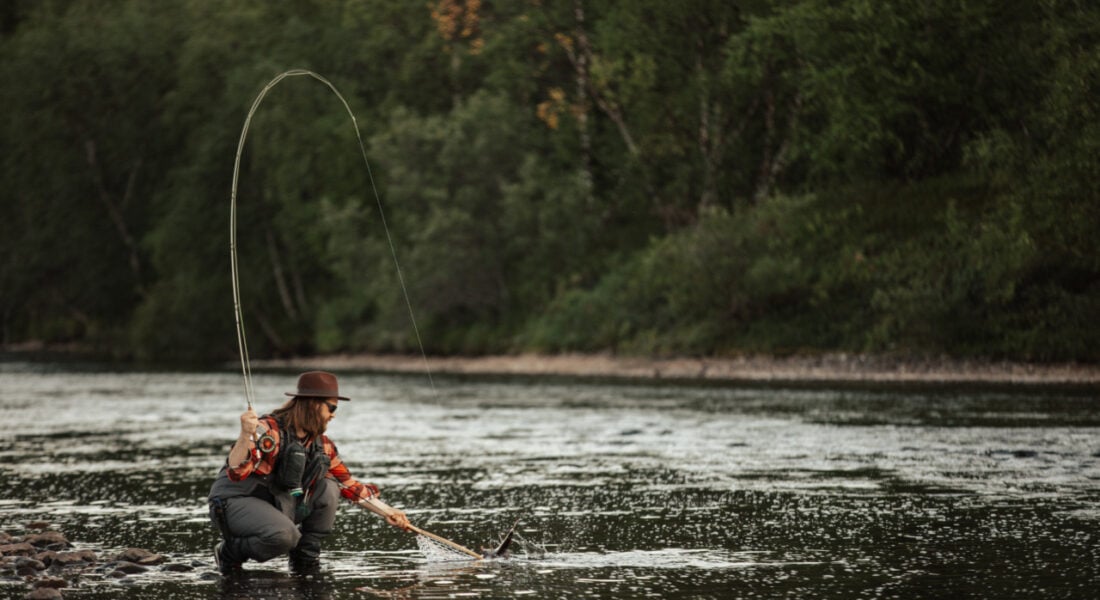
Fishing spots in the area
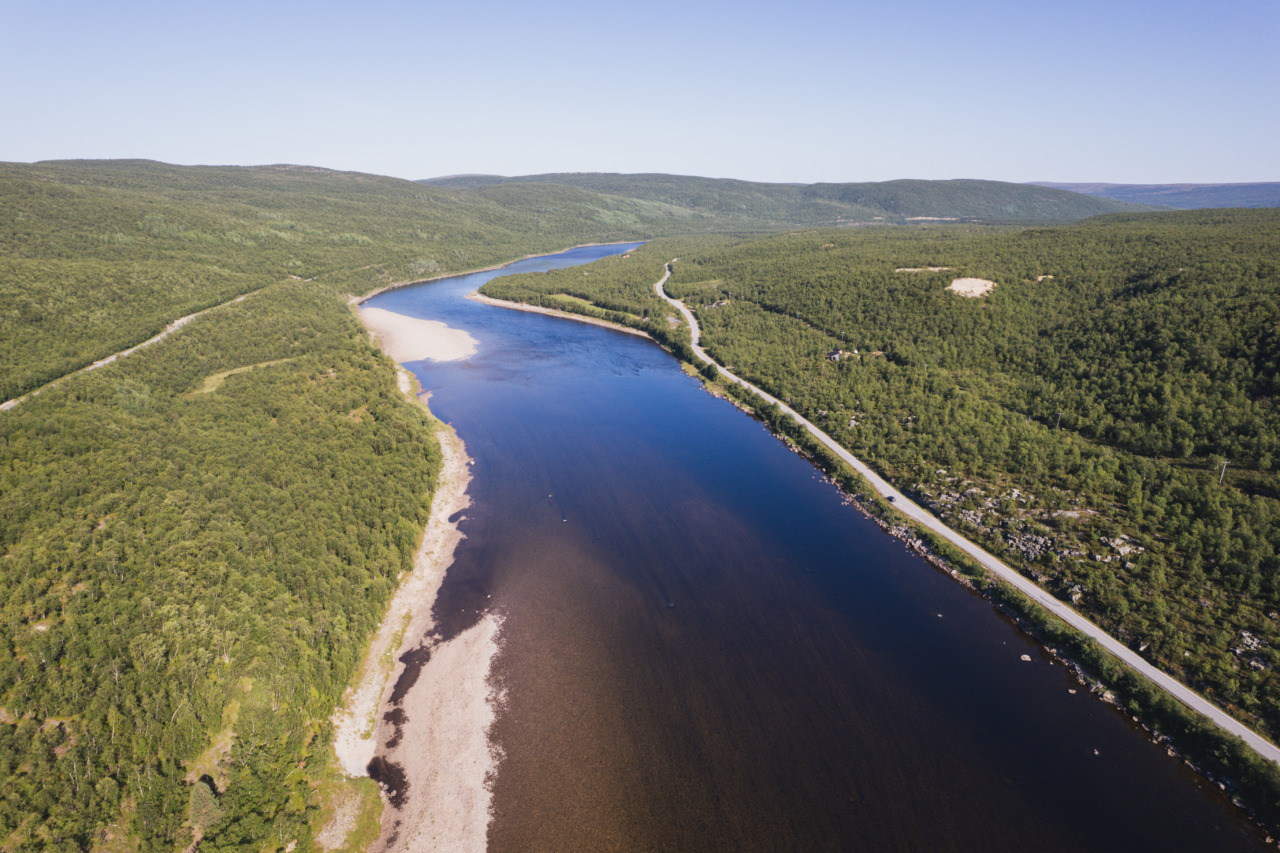
Teno River - Deatnu
The Teno River and its main channel have been one of Europe’s most renowned and respected salmon rivers. It flows along the border between Finland and Norway, with a total length of approximately 360 kilometers. Flowing through the stunning fells of Lapland, the Teno has been a popular fishing destination among both local and international anglers for decades. The fishing experience in the Teno Valley is truly unique due to its natural beauty. The river alternates between fast-flowing sections and calmer stretches, providing diverse fishing areas. The Teno River system also includes many large and small tributaries, such as the Utsjoki, Inarijoki, and Karasjoki, offering alternative fishing opportunities beyond the main channel.
The Teno is particularly famous for its salmon, but it also offers opportunities for fishing other species, such as grayling, sea trout, and pink salmon. Due to the poor condition of salmon stocks, salmon fishing has been prohibited in recent years. When fishing in the main channel of the Teno River, it is essential to act responsibly, as the state of fish stocks requires careful management. The protection of salmon stocks and restrictions on salmon fishing are part of efforts to restore the river’s natural fish population. However, fishing for other species is permitted.
Grayling is a thriving species in the Teno’s main channel, and its average size has increased in recent years, now averaging around 40–45 cm. Sea trout populations have also strengthened in the main channel, with particularly large specimens caught each year. Pink salmon is an invasive species that has claimed territory in the Teno River, as well as other rivers flowing into the Arctic Ocean. In the main channel of the Teno, mass migration of pink salmon typically occurs around late June to early July during odd-numbered years, and fishing for them is allowed.
For visitors from outside the local area, fishing for species other than salmon in the Teno’s main channel is permitted under the current fishing regulations, specifically §10. Fishing is allowed from the shore with flies and lures, but fishing from boats is prohibited. Lures may have a maximum of one treble hook of size #8, and flies may have up to three single hooks. The leader thickness of the fishing line must not exceed 0.25 mm, and fly rods may be no larger than a single-handed rod of class #6. It is recommended to use barbless hooks and landing nets with rubber mesh.
The Teno River’s main channel and its tributaries are regulated under the cross-border river agreement between Finland and Norway. Fishing in these waters is governed by the Teno Fishing Regulations and its Tributary Regulations. The implementation of the regulations is overseen by the Lapland ELY Centre and the Teno Fishing Area, which are responsible for permit sales and supervision. Fishing regulations may vary annually, so checking the most up-to-date rules is essential.
Fishing permits for the Teno’s main channel can be purchased from the Teno Fishing Area’s online store at tenonkalaluvat.fi. Fishing regulations and additional information about fishing arrangements and preventing the spread of the Gyrodactylus Salaris salmon parasite can be found, for example, on the Lapland ELY Centre’s website.
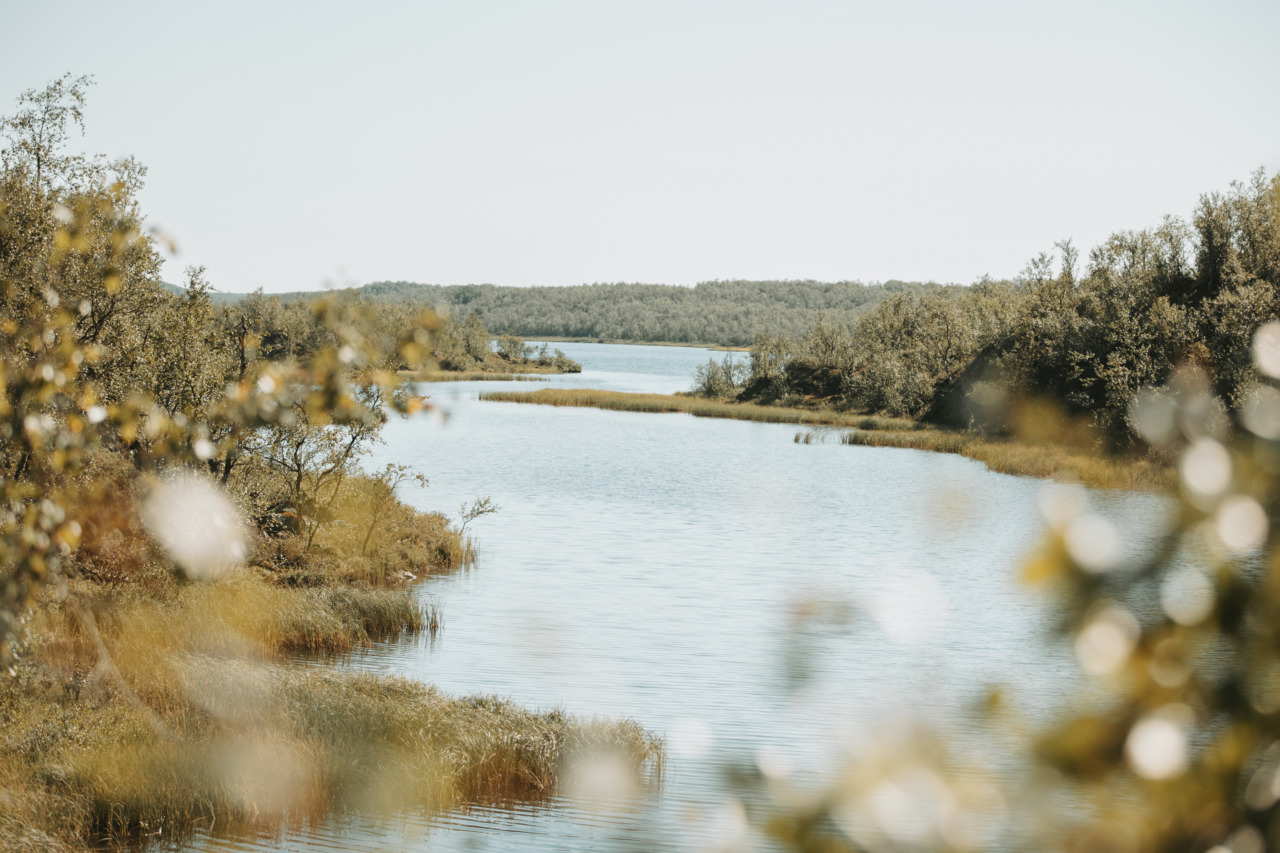
Mountain Areas – Kaldoaivi and Paistunturi
The mountain areas of Paistunturi and Kaldoaivi in Northern Lapland offer excellent opportunities for trout fishing in scenic and peaceful environments. The Kaldoaivi area boasts numerous streams, rivers, and lakes inhabited by species such as whitefish, perch, grayling, and trout. Paistunturi is known for its clear waters and remote tranquility. The wilderness’s remoteness and rugged terrain guarantee a calm fishing experience but require careful planning and preparation. A recent map, compass, and functional GPS device are essential equipment for anyone venturing into the fells.
The clear running waters of the mountain areas host natural trout populations, particularly in remote streams and rapids. However, trout fishing requires patience and often long hikes. The waterways also provide excellent opportunities for grayling fishing, especially during spring and summer. Grayling is commonly found in both rapids and calm stretches. Whitefish can be found in larger lakes and their shallow areas. During summer, whitefish can be caught from the shore or by boat, and in winter, through ice fishing. The area’s clear and cool mountain lakes are renowned for their legendary arctic char.
Lure fishing requires those aged 18–69 to pay the national fisheries management fee and possibly obtain a regional fishing permit. The permit number for Kaldoaivi is 1302, and for Paistunturi, it’s 1301. Wilderness area lure fishing permits cover most of the area’s waters. Independent ice fishing is allowed under everyman’s rights in most of the standing waters of these areas. Necessary permits should be checked at retkikartta.fi and purchased from eraluvat.fi. Water bodies where fishing is prohibited can be verified at kalastusrajoitus.fi.
The basic principles for fishing are as follows: Under everyman’s rights, independent ice fishing and angling are allowed. Lure fishing is permitted in most standing waters, such as lakes and ponds, with a paid fisheries management fee. Fishing in flowing waters, such as rivers and streams, requires a regional lure fishing permit.
Fishing licenses
Every angler is responsible for ensuring that they possess the appropriate and valid fishing permits.
On the main channel of the Teno River, all anglers must have a valid permit issued by the Teno Fishing Area. An example of this is the “Shore Fishing Permit for Other Species”, which allows fishing for species other than salmon. In addition to the regional permit, all anglers aged 18–69 must have paid the Fishing Management Fee.
Fishing in the tributaries of the Teno River requires a valid permit from the local shareholders’ association. Permits are available for at least the Utsjoki and Vetsijoki rivers. Information about permit sales from the shareholders’ associations can be found on the fishing area’s website.
In the fell areas, the basic principle for fishing is as follows:
- Ice fishing and angling are allowed under Everyman’s Right.
- Lure fishing is allowed in most standing waters, such as lakes and ponds, with the Fishing Management Fee.
- Fishing in flowing waters, such as rivers and streams, requires a regional fishing permit. The permit number for the Kaldoaivi fishing area is 1302 and for the Paistunturi fishing area is 1301.
Responsible Fishing
responsible angler understands the status of fish stocks in the waters they are fishing or consults a local fishing guide to gain that knowledge. A responsible angler only catches what the fish population can sustain and no more than what they personally need. Additionally, they ensure that the equipment used is appropriate for the specific fishing activity and target species, and they use a landing net with a rubber-coated mesh. A responsible angler is also mindful of other people in nature, follows the Off-Road Traffic Act, and uses existing paths to minimize wear and tear on the terrain.
Barbless hooks make it easier to release fish and improve their chances of survival when returned to the water. When using lures with multiple hooks, releasing the fish is often unreasonable after unhooking, as removing several deeply embedded hooks causes too much harm to the fish. Even minor bleeding from the fish’s mouth indicates reduced chances of survival. Injured fish should be killed as quickly as possible.
Fishing should be avoided when the water temperature exceeds 21°C, as fish are unlikely to survive air exposure. For salmonids, even a minute out of water can be lethal. A fish intended for release should be returned to the water as quickly as possible.
Responsible fishing also has a role in fish stock management: the vitality of fish populations is preserved through responsible fishing practices. For example, fishing for fish that prey on salmon juveniles helps support the well-being of salmon stocks. Harvesting undersized individuals from overabundant fish species is also encouraged. A good example of this is thinning out dense perch populations.
Read more about responsible fishing in Lapland’s waters from the Fishing Lapland – Handbook for Responsible Fishing Tourism, produced by Lapin Kalastusmatkailu ry.
FISH SPECIES
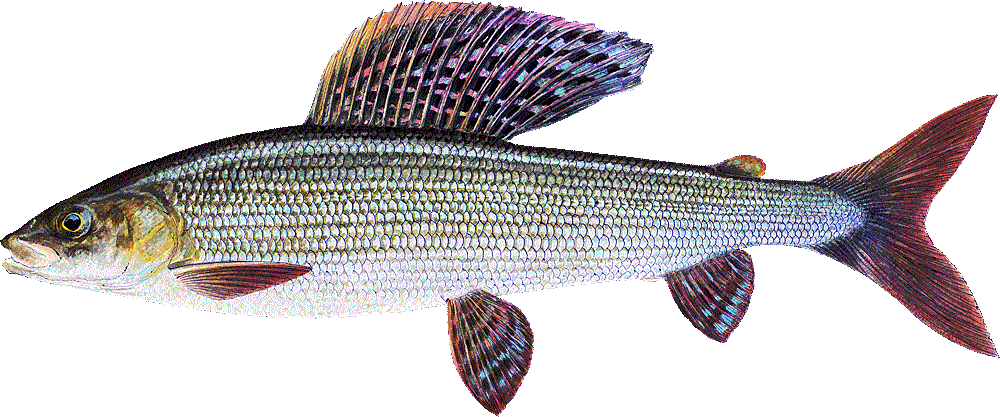
Grayling (Thymallus thymallus)
The grayling is a highly regarded salmonid species known particularly for its tall, beautifully colored dorsal fin. It is a popular target among anglers due to its active behavior. The grayling is quite common in the Teno River system and other clear waters of Northern Lapland.

Grayling (Thymallus thymallus)
The grayling is a highly regarded salmonid species known particularly for its tall, beautifully colored dorsal fin. It is a popular target among anglers due to its active behavior. The grayling is quite common in the Teno River system and other clear waters of Northern Lapland.
Grayling can be found especially in the calm sections and edges of the Teno River’s main channel, where the water flows moderately. They often prefer shallower, slightly flowing areas where they wait below the surface for insects drifting with the current.
The clear fell lakes and remote ponds of the Teno River system are also excellent grayling waters. In these waters, grayling often gather in shallow areas and shore zones, particularly during spring and summer evenings when insects hatch on the surface. The region’s small streams and large ditches can be true grayling treasures where the fish thrive in sheltered spots.
For fly fishing grayling in the Teno River system, a #3–#5 weight fly rod and a light line are sufficient. The ideal hook sizes are #12–#16, small enough to attract grayling yet effective. In clear weather, lighter or natural colors like olive and brown are preferred, while in dim light and at night, darker flies work best. Grayling often feed along the stream’s edge or in shallow calm spots where food drifts by easily.
Fly selection should be adjusted according to the time of day.
- Morning: When the water is cooler, grayling are often active near the surface. Dry flies like Elk Hair Caddis, Klinkhåmer, or Adams in sizes 12–16 work well. Light nymphs and emergers are also worth trying.
- Daytime: Insects become more active as temperatures rise, and grayling may rise more actively to dry flies. During bright conditions and calmer waters, more subtle flies may be required. Try imitating surface insects with CDC Caddis, Black Gnat, and Olive Dun. When fishing below the surface, small nymphs and pupae such as Caddis Pupa or Zebra Midge are worth experimenting with. If the grayling doesn’t rise, it may be necessary to use wet flies or streamers, particularly in deeper spots.
- Evening: Grayling are often most active in the evening. Insect hatches and swarming attract them in large numbers. Their diet can be imitated with dry flies like Elk Hair Caddis (brown or olive), Mosquito, and Black Klinkhåmer. In the surface film and just below it, try various emergers that imitate insects struggling on the surface.
- Night: While the Teno River’s summer nights are bright, grayling can be more cautious and tend to sink to deeper waters. During night fishing, dark flies that are visible to fish in low light are most effective. Surface flies like Black Gnat and Dark Hendrickson, as well as dark and small streamers like Woolly Bugger or Black Leech, work well.
The Teno River system offers excellent grayling fly fishing opportunities throughout the summer and fishing season from June 10 to August 10. Dry flies, nymphs, and streamers can all be effective when selected according to the time of day and water conditions. Particularly memorable for many anglers is the experience of dry fly fishing during the bright summer nights along the legendary Teno River.
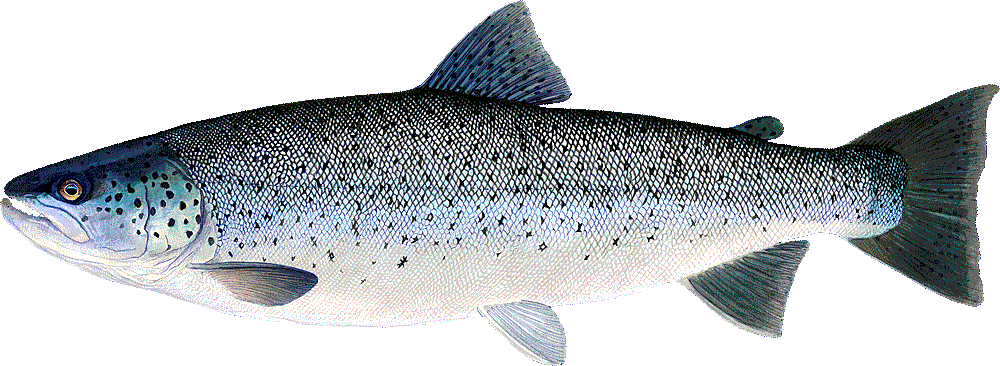
Brown Trout (Salmo trutta)
The brown trout is found in the Teno River system in three ecological forms: the sea trout (Salmo trutta), the lake trout (Salmo trutta lacustris), and the brook trout (Salmo trutta fario).

Brown Trout (Salmo trutta)
The brown trout is found in the Teno River system in three ecological forms: the sea trout (Salmo trutta), the lake trout (Salmo trutta lacustris), and the brook trout (Salmo trutta fario).
These forms differ based on their habitat and migratory behavior. The clean, cool flowing waters of the Teno River provide ideal conditions for brown trout, but maintaining healthy trout populations requires responsible management and conservation efforts. Brown trout can be easily distinguished from salmon by their almost straight-edged tail, the distinct mouth extending behind the eye, and spots extending down to the belly. Sea trout, which migrate from the sea and are locally found, can be identified by their coloring: sea trout are much brighter than local individuals.
The sea trout is the most significant ecological form in the Teno River system. It migrates to the Barents Sea to grow, where abundant food allows for rapid growth. Adult individuals return to their home rivers in the spring to spawn. The tributaries and brooks of the Teno River serve as important spawning grounds for the sea trout, and the oxygen-rich gravel beds in flowing water provide optimal conditions for the development of eggs. The sea trout’s life cycle and survival depend on the quality of spawning sites and the accessibility of migration routes. The lake trout is found particularly in the upper reaches of the Teno River system, where it can spend part of its life in lakes. Spawning occurs in fast-flowing waters in the fall, as it does with other forms of brown trout. The brook trout, on the other hand, lives its life in small tributaries of the Teno River system. In these environments, brown trout often remain small due to limited food availability. Brook trout use the gravel beds of the streams for spawning and thrive in clear, cool water typical of the upper reaches of the Teno River and its tributary brooks.
A brown trout angler can target the main river’s fast-flowing stretches and larger pools, as well as the area’s smaller rivers, brooks, or the clear lakes of the tundra region. Brown trout prefer waters with rocky, fast-flowing areas and the shallower parts of lakes. The most important factor for the brown trout’s well-being is the availability of food, such as insects, sticklebacks, and vendace. Anglers should also consider the time of day when fishing for brown trout. Larger individuals are usually found in the shallower parts of the waters and along the edges of currents during the evening and night, or when the light shifts toward dusk. During the day, brown trout are best targeted in deeper or faster-flowing parts of the water.
Popular and effective flies for brown trout fishing are available in all types: dry flies, nymphs, and streamers. For dry flies, examples include Elk Hair Caddis, Goddard Caddis, and Klinkhammer. For nymphs, Pheasant Tail and Hare’s Ear are effective. For streamers and small fish imitations, Muddler Minnow, Zonker, and Woolly Bugger are also good choices. When using imitation flies, natural colors (olive, brown, gray) should be used, but in the evening and in murkier waters, brighter colors (orange, red) may work better when fishing with nymphs and streamers. The strength of the brown trout and its excellent eyesight should be considered when selecting the leader line.
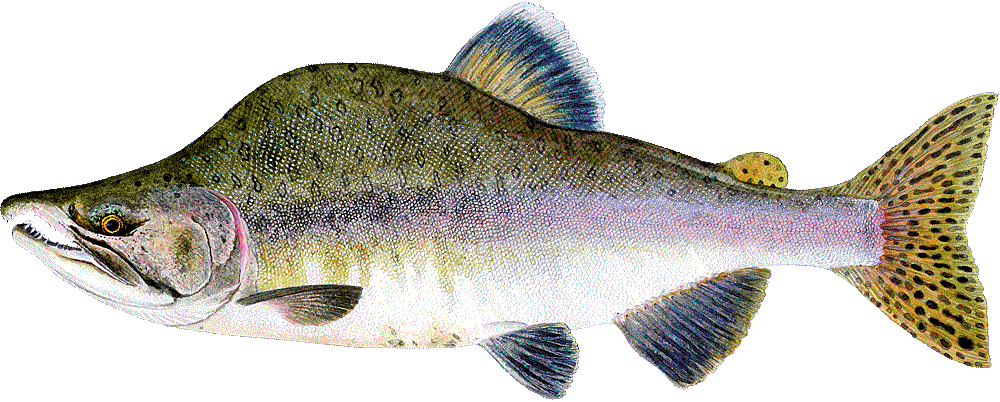
Humpback / Pink Salmon (Oncorhynchus gorbuscha)
The humpback or Pink salmon is an invasive species commonly found in the Teno River system as well as the Näätämö River. It spawns in these rivers that flow into the Arctic Ocean during odd years and migrates upstream in mid-summer.

Humpback / Pink Salmon (Oncorhynchus gorbuscha)
The humpback or Pink salmon is an invasive species commonly found in the Teno River system as well as the Näätämö River. It spawns in these rivers that flow into the Arctic Ocean during odd years and migrates upstream in mid-summer.
Its fly and lure fishing has become increasingly popular worldwide and has quickly gained traction in the Arctic Ocean rivers. It is a popular recreational fishing target, especially in North America along the Pacific Coast. The Pink salmon eagerly bites the lure and provides a fierce fight, offering enjoyable moments for anglers. In the main channel of the Teno River, the mass migration of Pink salmon typically occurs around Midsummer and mid-July. Along the Arctic coast near river mouths, they can be fished starting from mid-June.
A light one-handed fly rod is sufficient for fly fishing for Pink salmon. According to the Teno River fishing regulations, the fly rod must be no heavier than a #6 weight. The regulations also specify that floating fly lines should be used for fishing for Pink salmon. The leader line should be no thicker than 0.25 mm. It is recommended to use fluorocarbon leaders, as they withstand the fish’s teeth a bit better. Lure fishing is also allowed, as per the Teno River fishing regulations. The lure can have only one treble hook, no larger than size #8. Lures should feature bright colors like orange and pink, as well as other fluorescent hues. It is best to retrieve the lure slowly, letting it “drift” with subtle tugs to provoke a strike. Pink salmon prefer shallow, but moderately flowing shorelines and areas where they can be targeted by fly fishermen. The best times to catch them are early mornings and evening twilight when they are most active.
Pink salmon must not be released back into the Teno River system. They should be killed as quickly as possible after being caught. Pink salmon is an excellent food fish, rich in nutritional value, and can replace Atlantic salmon in any salmon recipe. The skin of the Pink salmon is also ideal for crafts, making its fishing in the Teno River system highly recommended.
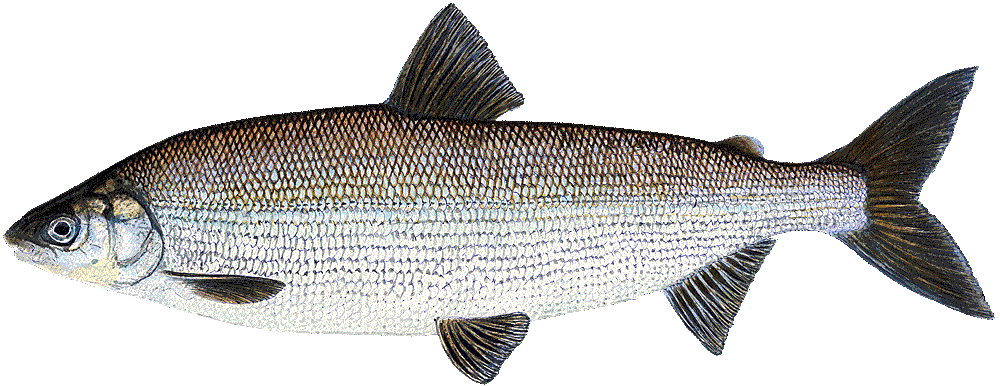
Whitefish (Coregonus lavaretus)
The whitefish is a highly valued and diverse species of salmonid that thrives in cool and clean waters. It is a slender, silvery fish with a darker back and relatively large scales.

Whitefish (Coregonus lavaretus)
The whitefish is a highly valued and diverse species of salmonid that thrives in cool and clean waters. It is a slender, silvery fish with a darker back and relatively large scales.
Its mouth and head shape are influenced by its lifestyle: the whitefish can either be a lake-dwelling bottom feeder or a plankton-eating whitefish. Whitefish inhabit a variety of environments and are found in many types of water systems. They prefer clear, oxygen-rich lakes that provide suitable conditions for both plankton-feeding and bottom-feeding whitefish. The clear, shallow lakes and ponds of the tundra region offer excellent living conditions for the species. In these waters, whitefish are often smaller in size but excellent in taste. In Upper Lapland, there is also a migratory form of the species, which moves from rivers to lakes and the sea. Whitefish in the Teno River and its tributaries migrate to the gravel beds of the rivers in the fall to spawn. In rivers and streams, whitefish favor calmer sections along the banks, shallow pools, and areas near bottom rocks. During the summer, whitefish often come close to the shore, where they feed on insects and larvae on the surface.
Fly fishing for whitefish is a precise and technical form of angling that requires light tackle, thin lines, and the right kinds of flies. A light rod in the #3–#5 range is ideal, with fiberglass rods being particularly suitable for whitefish fishing. A thin leader, such as 0.12–0.18 mm, is necessary because whitefish are cautious and can easily detect thick lines. Effective dry flies include small emergent patterns and Klinkhamers. For nymphing, whitefish are attracted to small nymphs such as the Pheasant Tail Nymph, Hare’s Ear Nymph, and Zebra Midge. Careful presentation is key when fishing for whitefish. The best places to catch whitefish are in clear lakes and slow-moving river sections, especially on summer evenings when they feed on the surface.
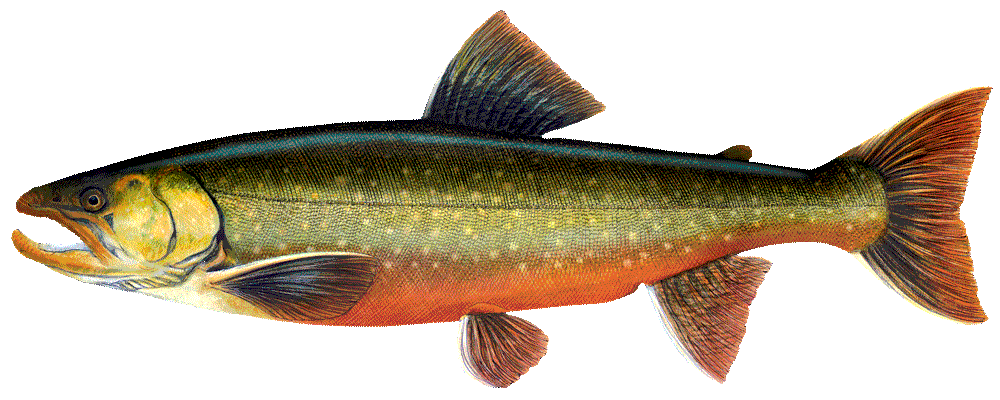
Arctic Char (Salvelinus alpinus)
The Arctic char, also known as the “northern trout,” is a cold-water fish belonging to the salmon family. It is known for its beautiful appearance: its silvery side, reddish fins, and speckled body make it easily recognizable. The Arctic char thrives in cool, oxygen-rich waters, preferring northern lakes and mountain streams

Arctic Char (Salvelinus alpinus)
The Arctic char, also known as the “northern trout,” is a cold-water fish belonging to the salmon family. It is known for its beautiful appearance: its silvery side, reddish fins, and speckled body make it easily recognizable. The Arctic char thrives in cool, oxygen-rich waters, preferring northern lakes and mountain streams
The Paistunturi and Kaldoaivi fell areas are famous for their excellent char waters. These areas have several remote, shallow, and crystal-clear lakes and ponds that are ideal for Arctic char. The tributaries and upper reaches of the Teno River may contain smaller char populations.
The Arctic char is highly adaptable and occurs in three main forms: the local lake char, the anadromous sea char, and the permanently small dwarf char. Local chars are typically found in mountain lakes and ponds, feeding mainly on insects, crustaceans, and small fish. Growth in these waters is slow, but the fish can be long-lived. Dwarf chars, which feed on plankton and invertebrates, have limited growth potential due to their poor diet. Sea chars migrate to marine areas to feed and return to rivers to spawn, typically growing larger than the local populations.
Several factors can influence successful Arctic char fishing. Dusk and dawn are often the best times to fish for char. Calm weather and clear water provide optimal conditions, but on cloudy days, char may be more active. Char are cautious in clear water, so approach fishing spots carefully and avoid making excessive noise. In mountain lakes and ponds, char often move in schools, circling the waters in search of food.
Arctic char can be caught with small spoons, spinners, or flies. Surface flies, such as those imitating mayflies, dragonflies, and midges, are particularly effective.

Pike (Esox lucius)
The pike is one of the most common and targeted predatory fish in Finland, also found in the Teno River system and the wilderness areas of Northern Lapland. The pike populations living in Lapland’s clean and clear waters play an essential role in maintaining the aquatic ecosystem’s balance, while also producing truly large specimens.

Pike (Esox lucius)
The pike is one of the most common and targeted predatory fish in Finland, also found in the Teno River system and the wilderness areas of Northern Lapland. The pike populations living in Lapland’s clean and clear waters play an essential role in maintaining the aquatic ecosystem’s balance, while also producing truly large specimens.
The pristine environment of Lapland makes its pike excellent for eating. In the Utsjoki area, pike fishing offers a great opportunity to experience the waters of the Arctic fell region, as pike thrive in various habitats and provide exciting moments for anglers.
The main channel of the Teno River is renowned for its salmon, but nowadays, pike are also increasingly found there. Pike living in the main channel and its tributaries prefer slower-flowing sections and sheltered bays within calm pools. Occasionally, pike can also be found in rapids and particularly in their tailwaters. In the fell region, pike can be found in most lakes and ponds.
Pike can be caught with lures or flies, respecting local fishing regulations. When fly fishing, pike readily strike large streamers and poppers. Recommended fly-fishing gear includes a strong rod and a durable leader to protect the line from the pike’s sharp teeth. In the main channel of the Teno River, a fly rod of up to #6 weight single-hand rod and a leader with a thickness of 0.25 mm are allowed. For fishing in the fell areas, heavier equipment is recommended.
When selecting lures and flies, having bright colors is essential. Effective colors include green, yellow, red, orange, silvery, and black.
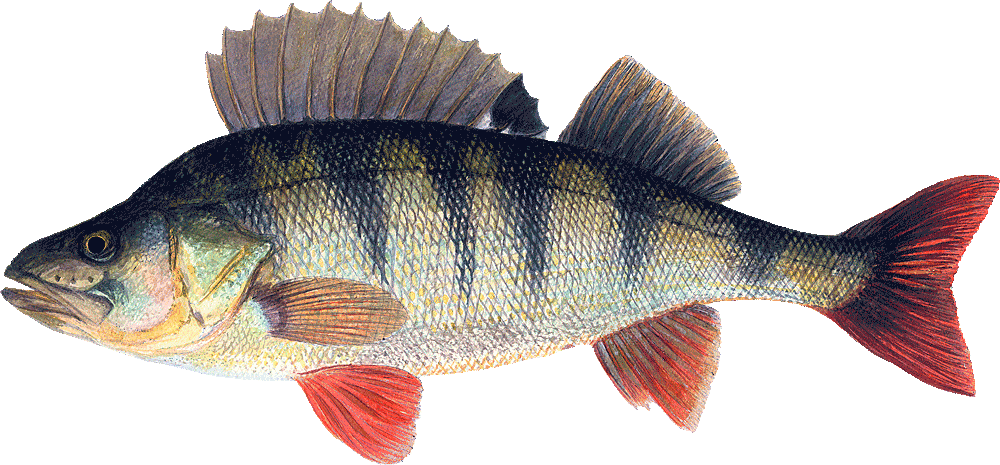
Perch (Perca fluviatilis)
The perch is Finland’s national fish and the most common and versatile fish species in our waters. It thrives well in the waters of the Utsjoki and Teno River Valley areas. The perch is easily recognizable by its greenish or grayish back, dark vertical stripes on its sides, and reddish or orange lower fins. Resilient and adaptable, the perch inhabits not only the calm sections of the Teno River’s main channel but also the fell areas, including lakes, rivers, and smaller ponds.

Perch (Perca fluviatilis)
The perch is Finland’s national fish and the most common and versatile fish species in our waters. It thrives well in the waters of the Utsjoki and Teno River Valley areas. The perch is easily recognizable by its greenish or grayish back, dark vertical stripes on its sides, and reddish or orange lower fins. Resilient and adaptable, the perch inhabits not only the calm sections of the Teno River’s main channel but also the fell areas, including lakes, rivers, and smaller ponds.
Light spinning gear works well for perch fishing, such as small spinners like Mepps and Vibrax or small spoon lures. Jigging is also an effective way to catch perch. Particularly recommended for the fell waters are small, colorful micro jigs.
Fly fishing for perch is a fun and versatile method because perch are active, easily attracted, and common. It’s also suitable for beginner fly fishers, as perch eagerly bite on lures and provide enjoyable resistance with light fly-fishing gear. It’s advisable to use relatively light fly rods and floating fly lines.
Perch will go for a variety of flies, ranging from small streamers to dry flies. Especially effective are small baitfish imitations with colors such as black, green, orange, and silver.
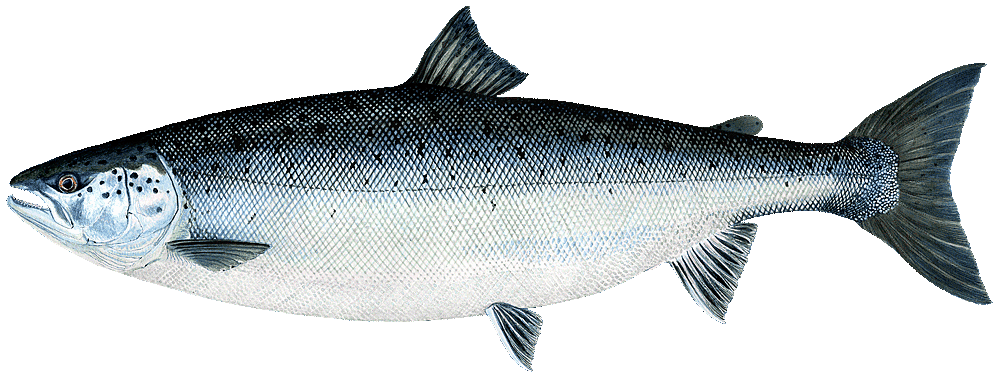
Salmon (Salmo salar)
The salmon (Salmo salar), the king of the river, swims through the powerful rapids towards the upper reaches. The journey begins when the salmon is a smolt, migrating to the open sea to grow. Once fully grown, the salmon returns from the sea to the river to spawn in the upstream gravel beds.

Salmon (Salmo salar)
The salmon (Salmo salar), the king of the river, swims through the powerful rapids towards the upper reaches. The journey begins when the salmon is a smolt, migrating to the open sea to grow. Once fully grown, the salmon returns from the sea to the river to spawn in the upstream gravel beds.
Some salmon may spend up to four years in the sea before their first spawning journey. Typically, salmon spend two years at sea, growing to weights of 3–8 kilograms. Some individuals may return to the river up to three times and grow to over 20 kilograms. Salmon only feed in the sea, so it remains a mystery why they bite lures.
Salmon fishing on the Teno River has a long and significant history, stretching back centuries. The Teno River salmon has been a central part of the lives and livelihoods of the local Sámi people and other residents of the region. Fishing was originally practiced primarily for sustenance using traditional methods such as nets, hook and line, weirs, and drift fishing. In the 19th century, and especially in the early 20th century, the salmon fishing on the Teno River began to attract fishing tourists, particularly British gentlemen, who brought with them the tradition of fly fishing. The Teno River became a world-class salmon river, and famous fly fishermen helped make the region a renowned fishing destination.
The status of the salmon in the Teno River system has been concerning in recent years, sparking widespread discussion among anglers, researchers, and authorities. The Teno River’s salmon population has traditionally been one of the world’s most important wild salmon populations, but in recent years, the numbers of salmon have dramatically declined. Currently, fishing for salmon in the Teno River system is prohibited in order to protect the population.
Gyrodactylus salaris
Gyrodactylus salaris is a small salmon parasite that lives on the skin of salmon and is particularly harmful to salmon populations. The spread of this parasite to new water bodies poses a significant threat, and anglers must follow specific precautions to prevent its spread. This is especially important in sensitive salmon areas like the Teno River, where protecting salmon populations is crucial.
Gyrodactylus salaris
Gyrodactylus salaris is a small salmon parasite that lives on the skin of salmon and is particularly harmful to salmon populations. The spread of this parasite to new water bodies poses a significant threat, and anglers must follow specific precautions to prevent its spread. This is especially important in sensitive salmon areas like the Teno River, where protecting salmon populations is crucial.
How Anglers Can Prevent the Spread of Gyrodactylus salaris
- Drying and Disinfecting Equipment
- Dry your fishing gear thoroughly: The parasite’s eggs and spores can survive in moist fishing equipment for several days. Thorough drying of gear (for at least 48 hours) is an effective way to prevent the spread.
- Disinfect your equipment: If drying is not possible, gear should be disinfected with special disinfectants such as Virkon-S solution or hot water (at least +60 °C).
- Disinfection stations are available especially in the Teno River fishing area, and their use is recommended and often mandatory.
- Avoid Transferring Equipment Between Water Bodies
- Do not use the same fishing equipment in multiple water bodies without disinfecting them. This applies to:
- Rods, reels, lines, lures, and flies.
- Wading gear (boots, waders).
- Do not use the same fishing equipment in multiple water bodies without disinfecting them. This applies to:
- Boats, canoes, or other watercraft.
- If fishing in multiple water bodies, disinfection must always be carried out before moving to a new location.
- Using Disinfection Stations
- Official disinfection stations are located in the Teno River area and other salmon river areas.
- Anglers should use these stations, as they provide the correct substances and methods for cleaning equipment.
- Proof of disinfection may be required before fishing can begin, which is common practice along the Teno River and other protected areas.
- Prohibition of Transferring Fish and Water Between Water Bodies
- Never transfer fish, water, or other biological materials from one water body to another.
- This includes baitfish and animal-based lures, which are prohibited in the Teno River.
- Also, avoid leaving water in your gear or boats.
- Follow Regional Guidelines and Regulations
- Before fishing, check the official regulations and guidelines for the area, such as fishing rules and equipment disinfection requirements.
- Compliance with regulations is mandatory when fishing in the Teno River and other sensitive areas.
- Responsible Fishing and Sharing Information
- Spread awareness about the risks of the parasite to other anglers.
- Lead by example and follow all guidelines, even if they are not strictly enforced.
- Report to authorities if you observe sick fish or suspect the presence of the parasite in water bodies.
Summary
Gyrodactylus salaris is a serious threat to salmon populations. However, anglers can effectively prevent its spread by simple measures such as thorough drying of equipment, disinfection, and compliance with regional regulations. This is especially important in sensitive salmon areas like the Teno River, where protecting salmon populations is vital.
For more information and to find disinfection stations in the Teno Valley, visit the ELY Center’s website.
Activities in the area

70º North
Arctic-Siida
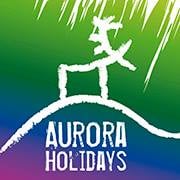
Aurora Holidays

Autentic Boreal
Hunting
Fishing
Photography Tailored outdoor experiences in Finnish Lapland and Northern Norway.
Camping Lapinkylä

Holiday village Valle
Hotel Guossi

Hotel Utsjoki

Kakslauttanen Arctic Resort, Utsjoki
Lohi-Aslakin Lomamökit Ky
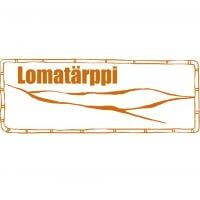
Lomatärppi

Nuorgam Holiday Village
Seitalan kalastus- ja matkailupalvelut
Tenon Eräkievari
Travel Utsjoki
Tundrasafari
Tunturilapin Rautu
Vetsikon leirintämökit




